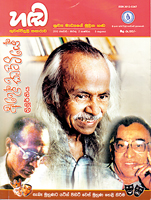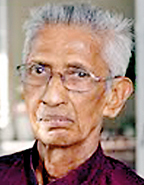‘Handa’ makes a big noise
Quality magazines produced in Sri Lanka are a rare commodity. This is true particularly of the Sinhala ones (sorry, I am unable to comment on Tamil language publications). In this context, I was quite impressed with veteran journalist Tillekerattne Kuruwita Bandara’s latest effort in producing an attractive and meaningful publication.
Having been the editor of a number of Sinhala weeklies, he has a wealth of experience which he is putting into good use in the current venture.
The publication titled ‘Handa’ (Sound) is published by the Sri Lanka Broadcasting Corporation (SLBC). The quarterly magazine is full of interesting articles, well written and presented in a simple but attractive way.

At a time when it’s fashionable to put in a lot of colour to create an impact, ‘Handa’ is proof that colour is not really essential to turn out a quality product. Except for the cover and an odd advertisement, ‘Handa’ is basically in black and white. What readers look for is good reading material. Colour is only a ‘sobane’ – a term frequently used to indicate bogus show.
SLBC –Radio Ceylon in the old days – has been turning out publications from early days. I remember ‘Tarangani’ during our school days – a handy publication with a fine collection of material. Just like ‘Tarangani’, the selection of articles in ‘Handa’ too is thoughtfully done.
Glancing through the past few issues, a distinct feature is that ‘Handa’ devotes each issue to either discuss a personality who has contributed much to the arts or a significant event.
The theme of the issue just released is the Sambuddhatva Jayanthi marking the 2600th anniversary of the Enlightenment of the Buddha. It’s however, different from the usual Vesak publications. ‘Handa’ is much more interesting. In addition to a wealth of timely features, it reminds the reader of the role played by Sri Lanka Radio’s service in the name of Buddhism. It introduced the chanting of ‘Karaneeya Metta Sutta’ invoking blessings on the listeners first thing in the morning and last thing at bedtime. In 1929, it started broadcasting Dhamma sermons four times a month.
A recorded commentary on the Kandy Perahera was broadcast in 1934. On November 23, 1939 Professor Gunapala Malalasekera and long-time secretary of the All Ceylon Buddhist Congress, Leelananda Caldera did a live coverage of the pinnacle-laying ceremony at Ruvanveli Seya. The latter did a commentary of the exposition of the relics of the chief disciples of the Buddha from the Colombo National Museum in 1947. The fifties saw special programmes for the Buddha Jayanthi. The rest is recent history.
‘Ape Kattiya’ is born
‘Ape Kattiya’ – the revolutionary theatre group was featured in the previous issue. Centring on its key ‘actor’ Sugathapala de Silva, the group had four other ‘pioneers’ – Cyril B Perera, Ralex Ranasinghe, G. W. Surendra and Vipula Dharmawardena. Each possessed tremendous talent in writing, painting, photography, acting and so on. Some of the articles reproduced from other journals relate interesting tales.
Sunil Mahindukula quotes the ace photographer and creative mastermind Ralex R on how the ‘Ape Kattiya’ was formed. “We started at a bar. That was around 1959. We used to have intellectual discussions on art. Normally these discussions should have happened in the universities. But we broke that tradition and started discussing at places like the bars. We always met at a time when it was time to have a drink. However, we didn’t drink because we wanted to meet. Neither did we meet because we wanted to drink.
Most of us were employed at K.V.G. de Silva’s. Surendra and Vipula worked in the paper called ‘Divaina’ which was in existence then. Cyril B was attached to the Indian High Commission. I worked on the ‘Catholic Messenger’ too. Whenever we met we chatted about the books we had read, about the plays and films we had seen. Cyril used to get books from the Indian High Commissions library. Sugath used to bring books from KVGs. We used to read them and come out with our theories. Sometimes we had heated arguments. Sugath used to vehemently criticise the plays he had seen. We used to tell him not to be criticising the whole time but he should produce a good play. It was after that that he wrote ‘Boardingkarayo’.
It was time to submit scripts for 1962. They wanted to submit Sugath’s script. They had to indicate which group was submitting the script. Each one of them suggested names. Cyril B scribbled ‘Api Kattiya’ on a piece of paper. Everyone liked it. Sugath later changed it to ‘Ape Kattiya’.
That year ‘Boardingkarayo’ won three awards – Best script, Best production & Best actor ( G. W. Surendra) – at the State Drama Festival. It was a landmark play since it brought back dialogue plays at a time when stylised plays were the order of the day.
‘Handa’ has also devoted issues to Professor Sarachchandra, Ananda Samarakoon and Tower Hall era.
comments powered by Disqus























